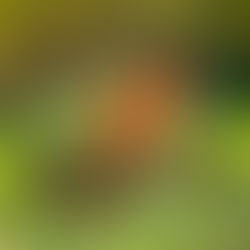The smallest kingdom with the richest flora, this is where diversity blooms
Cape Floral Kingdom
Within the borders of South Africa, almost solely in the Western Cape province, lies one of the 6 floral kingdoms of the world, the Cape Floral Kingdom. It has over 9000 different plant species, of which 69% can only be found here, creating the highest concentration of plant species in the world. It boasts some 1300 plant species per 1 million ha, while the South American rainforest has some 400 species per 1 million ha. In order to protect this natural wealth, this kingdom contains 13 areas which are protected as a UNESCO World Heritage Site.
Floral kingdoms are geographical areas with a relatively uniform composition of endemic plant species. The boundaries between these kingdoms are usually not sharp, but rather a transitional area with overlap of species from both kingdoms.
The entire Cape Floral Kingdom contains 4 different biomes – a geographical area with specific climate, vegetation and animal life – but the Fynbos biome is by far the largest in size (80%) and most species rich in the kingdom. Besides plant species from the Fynbos biome, you can also find species from the Succulent Karoo, Albany Thicket and Forest biome in this Kingdom.
8.600.000 ha
land size
9.000+
species
69%
endemic
7%
land of South Africa
0.3%
land of Africa
33%
species of South Africa
20%
species of Africa
1.700+
threatened species
3.000+
concerned species


WHERE IS THE
CAPE FLORAL KINGDOM
LOCATED
FYNBOS BIOME
The Fynbos biome is the largest within the Cape Floral Kingdom, covering some 80% of the area, and has by far the greatest diversity of plant species. Around 8000 plant species are found in this biome. The Fynbos biome is characterized by low-growing shrubs, heathlands and proteas, creating a beautiful carpet of colors and textures.

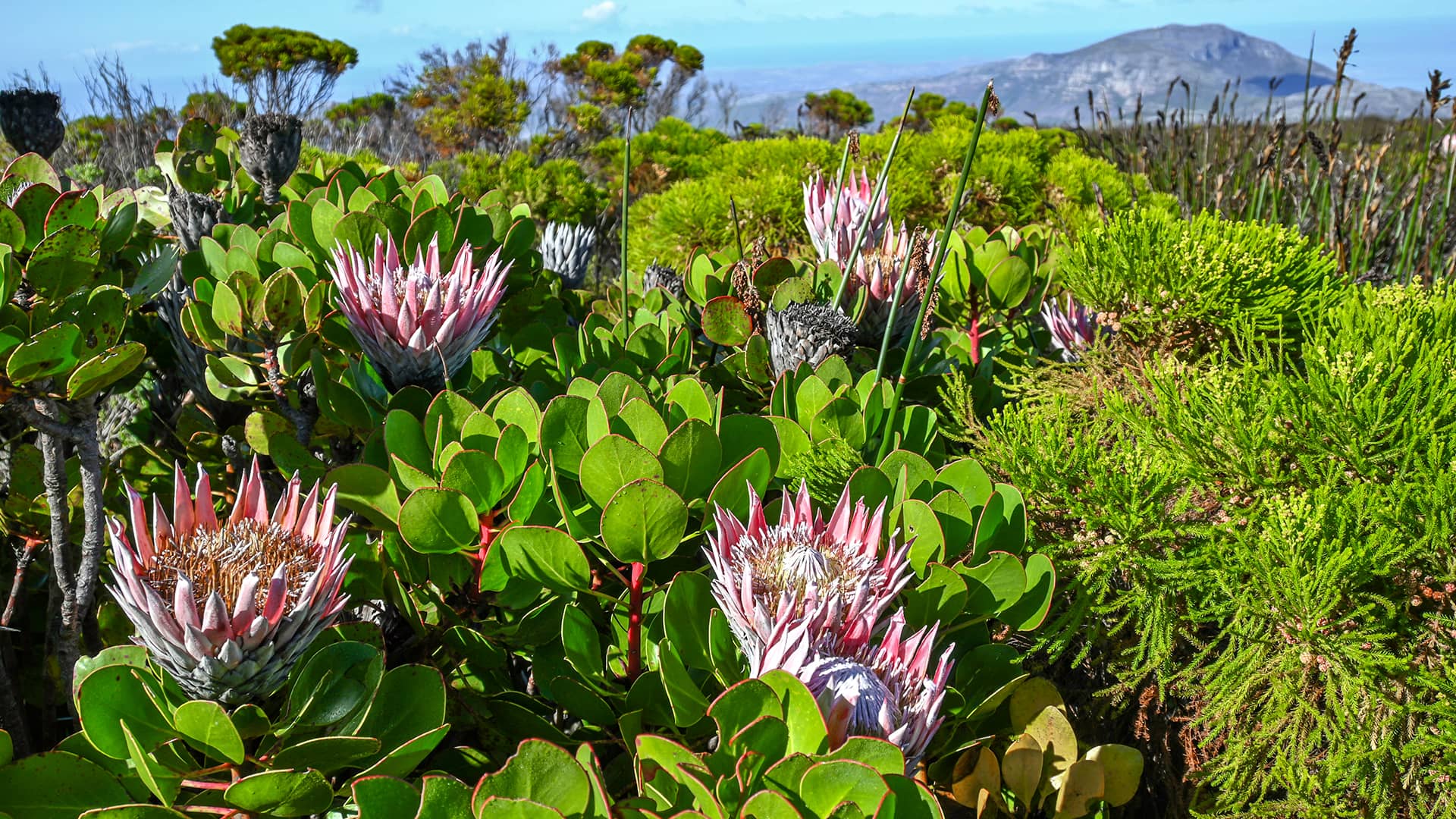
It can be divided into three vegetation groups; Fynbos, Renosterveld and Strandveld. Of these three, the Fynbos and Renosterveld are by far the largest. The Fynbos is usually found on the nutrient-poor mountains, whereas the Renosterveld is more at home on the fertile clay and silt soils of the lowlands. Strandveld is found closer to the seashore, but never in areas under direct influence of sea spray.
Fire is an important part in the life-cycle of the Fynbos and Renosterveld. Many of the plants germinate only after the intense heat of the fire, ideally in an interval of 10-15 years. If fires present themselves in the wrong season, or come too often, they can eliminate species. Besides fire, pollination is still very much a part of reproduction.
Fynbos
The Fynbos vegetation group is an evergreen shrubland that is characterized by the presence of more than 5% restios, a high coverage of ericoid shrubs and the common occurrence of proteas. In simple speak, members of the families of Restionaceae, Ericaceae and Proteaceae have to be present. Perhaps the most famous plant in the Fynbos biome is the national flower of South Africa; the King Protea (Protea cynaroides).
Ericaceae
Almost all of the species of this family, in the Cape Floral Kingdom, can be found in the genus Erica. This genus has over 850 species worldwide, with almost 700 of them in the CFK. When these plants are not in bloom, it can be quite difficult to tell the species apart, but in bloom - as you can see below - they are very diverse and beautifully colored.
Bay Heath
Gold Heath
Bottle Green Heath
Lip Heath
Hangertjies
Beauty Heath
Baby Heath
Purpletip Heath
Peninsula Heath Complex
Karos Heath
Salt-and-Pepper Heath
Roughpetal Heath Complex
Proteaceae
Proteas are able to produce some of the most beautiful flowers. No wonder the King Protea is the national flower. These woody plants are usually found on mountain slopes and foothills that have nutrient-poor soils.
Scarlet Sugarbush
Arid Pincushion
Rocket Pincushion
Tree Pincushion
Clanwilliam Sugarbush
King Protea
Grey Sugarbush
Bokkeveld Sceptre
Common Sugarbush
Golden Spiderhead
Swartkops Spiderhead
Wagon Tree
Restionaceae
This family is native to the southern hemisphere and can vary is size from just a few centimeters to 3m in height. These are reeds – although you might be mistaken them for grasses - with solid stems and no leaves. There are some 330 different species in the kingdom. Within the Fynbos biome, the restios play the part that the grasses play in other biomes.
Restio brunneus
Bright Thatchreed
Dew Capereed
Hookers Goldreed
Kouga Fountainreed
Elephant Reed
Rustling Goldreed
Broom Reed
Renosterveld
This vegetation group is dominated by evergreen shrubs from the family Asteraceae, in particular the species Renosterbush (Dicerothamnus rhinocerotis). Besides these shrubs, there usually is an understorey of grasses and a high diversity of geophytes. Many families and genera of plants are shared between the Fynbos and Renosterveld – apart from geophytes - but very few species are shared between these two.
Sticky Rain Daisy
Pale Felicia
Nasty Resinbush
White Buttons
Amphiglossa tomentosa
Giant Paraseed
Grapple Everlasting
Beetle Daisy
Heath Kapok
Pale Everlasting
Ash Gumbush
Renosterbush
Strandveld
Strandveld vegetation are medium dense to closed shrublands. It shares vegetational features with the Fynbos, Renosterveld and even Succulent Karoo biome. Restios are a common element here and when the annuals bloom, many plants from the Asteraceae and Aizoaceae families show off their beautiful colors. Strandveld vegetation tends to be smaller in size closer to the sea shore, but can grow larger in sheltered places. Unlike Fynbos and Renosterveld, fire plays a smaller role in the Strandveld vegetation.
Beaked Clockfig
Beach Gumbush
Brakslaai
Livingstone Daisy
Sandveld Ragwort
Coast Seacoral
Rain Daisy
Star of the Veldt
Sea fig
Dune Everlasting
Sprawling Seacoral
Sally-my-handsome
SUCCULENT KAROO BIOME
The Succulent Karoo biome is, after the Fynbos biome, the second most diverse biome in South Africa. Over 6000 plant species make up this biome and 40% of them are endemic. It also has the richest succulent flora in the world. About one-third of all succulent plants in the world can be found here. When it comes to the Cape Floral Kingdom, the Succulent Karoo biome plays just a small part, mainly found in the Little Karoo region.


Many of the succulent plants in this kingdom have found ingenious ways of adapting to the arid conditions of the region, where summers are dry and hot, and winters are cold with below average rainfall. The succulent plants have fleshy leaves or stems, with a waxy coating to reduce transpiration, in which they can store water. Stone plants (Aizoaceae) have developed a translucent layer in their upper leaf to get enough sunlight in, but also protect them from harmful UV-rays. Other plants have spiral-shaped leaves in order to protect them from the wind and retain moisture.
The vegetation in this biome is dominated by the plant families of Aizoaceae (Stone Plants), Crassulaceae (Stonecrop Family), Asteraceae (Sunflowers, Daisies, Asters, and allies) and Euphorbiaceae (Spurge Family).
Aizoaceae
These plants are called vygies in South Africa, meaning small fig, referring to the fruiting capsule that resembles the true fig. Worldwide, there are some 1800 different species in this family, of which 96% are endemic to the Succulent Karoo (the entire biome covers parts of South Africa and Namibia).
Stagfig
Fig Buttons
Rock Mesemb
Runner Mesemb
Robertson Tentfig
Western Fingerfig
Cerochlamys pachyphylla
Malephora uitenhagensis
Eastern Buttons
Fishlips Humpfig
Antegibbaeum fissoides
Babybum Humpfig
Asteraceae
These herbaceous plants are widespread across the world and can also be found in a wide variety of habitats all. But most of them are found in desert or semi-desert climates. The common characteristic of these plants are compound flower heads (a cluster of flowers arranged on the stem of a main branch).
Chaff Everlasting
Bitterbush
Good Karoo
Spiny Dollprotea
Fine Felicia
Buchu Gumbush
Alatoseta tenuis
Grey Everlasting
Pteronia oblanceolata
Cape Snow Bush
Pteronia adenocarpa
Lasiospermum brachyglossum
Crassulaceae
This is a diverse family of, usually, herbaceous plants, with succulent leaves and flowers that generally have 5 floral parts. Over 250 species can be found in South Africa, with one of the notable species being the Botterboom (Tylecodon paniculatus).
Silver Dollar Plant
Sandy Stonecrop
Pagoda Mini-Jade
Thorny Butterbush
Silver-Beads
Kebab Bush
Botterboom
Crassula hemisphaerica
Pig's Ear
Buddha's Temple
Crassula congesta
Concertina Plant
Euphorbiaceae
The Euphorbias come in many different forms, such as herbs, shrubs, trees or succulents, but are always characterized by milky latex (often poisonous). The succulent species are mostly confined to Africa. Many species have thorns and spines and are often confused with cacti. Some 190 species can be found in South Africa.
Mini Noors
Common Vingerpol
Robertson Barrelwort
Euphorbia hallii
Sweet Milkbush
Creeping Milkbush
Porcupine Vingerpol
Thorn Noors
Hedgehog Milkball
Yellow Milkbush
Hook Barrelwort
Teat Barrelwort
THICKET BIOME
Most of the Thicket biome can be found along the coastline of Kwazulu-Natal and the Eastern Cape. Within the Cape Floral Kingdom, these patches are located in the area around Oudtshoorn and the Baviaanskloof. This biome makes up some 3% of South Africa.

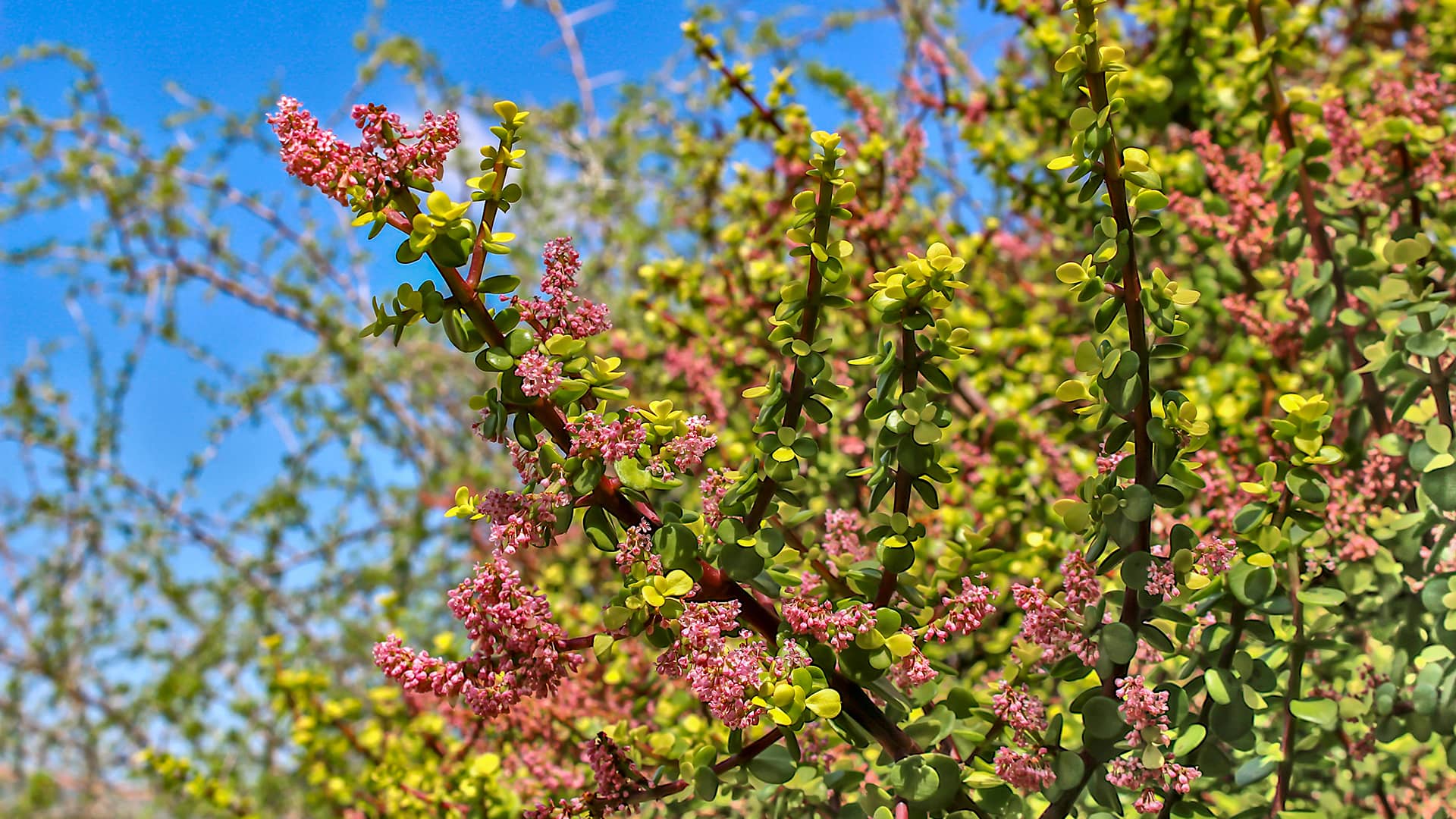
Thickets are dense groups of bushes and small trees. They are easily recognized as largely impenetrable shrubs, where many of the species have spines and are some 3m tall. Most species here produce berries, attracting fruit-eating birds such as Mousebirds, who disperse their seeds.
The Elephant Bush (Portulacaria afra) – also known as Spekboom - is the dominant species within the biome. It can grow up to 6m tall and 200 years old. Other prominent species are Cape Honeysuckle (Tecomaria capensis), Jade Plant (Crassula ovata), Gwarrie (Euclea undulata) and many species of the genus Euphorbia.
Splint Spike-Thorn
Num-Num
Cape Honeysuckle
Tilt-head Aloe
Sweet Thorn
Jade Plant
Elephant Bush
Karoo Boerbean
Gwarrie
Bottlebrush Asparagus
Coastal Turkeyberry
Cape Aloe
FOREST BIOME
This is the smallest of the biomes in South Africa, covering less than 1% of its land mass. Forest are characterized by a closed canopy and a rich underlayer of plants. In the south-western part of the kingdom, they are usually small patches that can be found in gorges and ravines. When you travel to the east, through the Garden Route, you will find larger areas of indigenous forest, including the largest; the Tsitsikamma forest. The forest richness and diversity also increases when travelling from south-west to east.

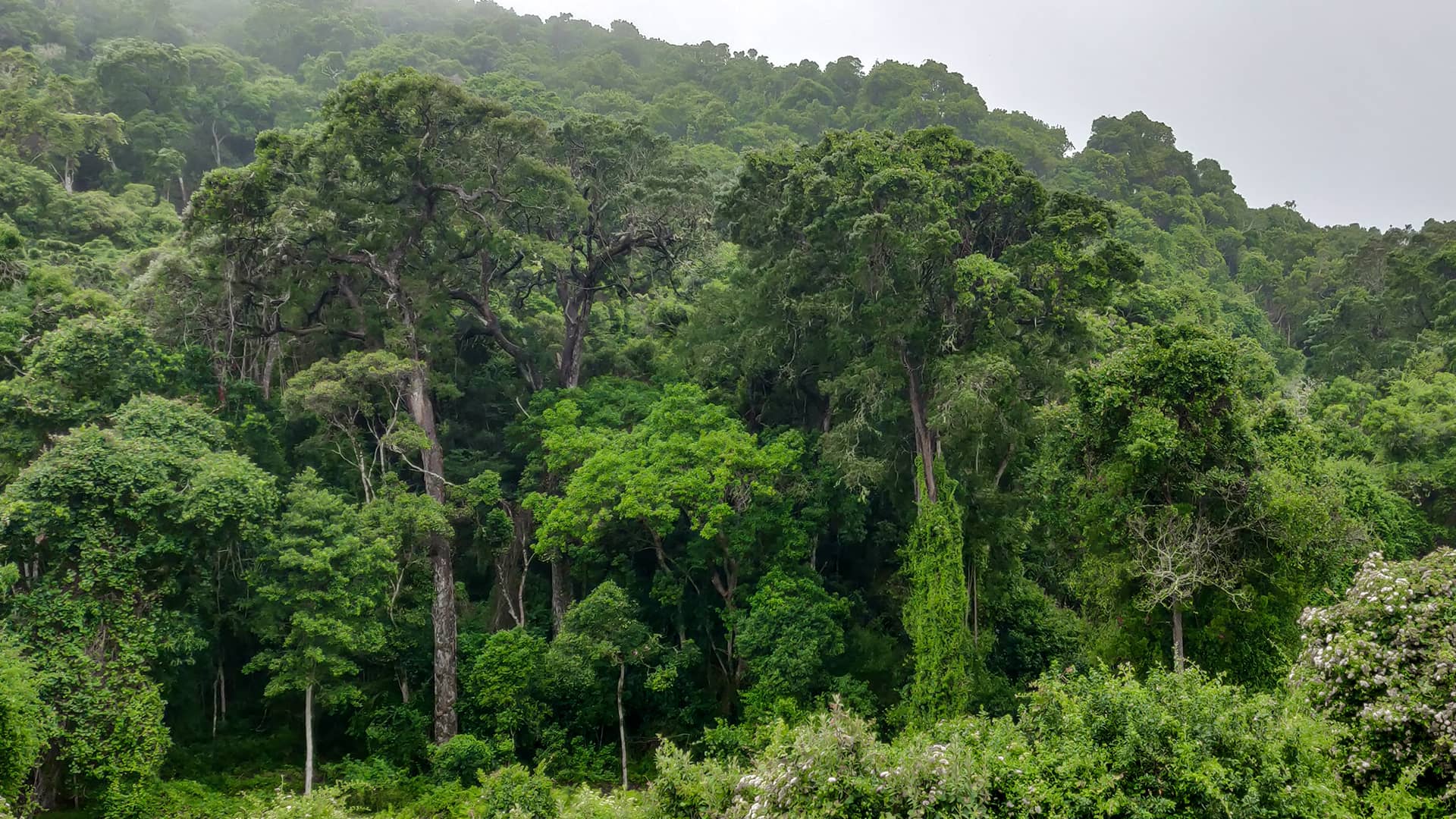
Although South Africa has a couple of different types of forest within the forest biome, in the Cape Floral Kingdom you will only find the Southern Afrotemperate Forest and the Southern Coastal Forest. Both these types are found from the Cape Peninsula in the west to the borders of the Eastern Cape province in the east. These forest types are dominated by Outeniqua Yellowwood (Afrocarpus falcatus), Real Yellowwood (Podocarpus latifolius), White Milkwood (Sideroxylon inerme), Coast Silver-Oak (Brachylaena discolor) and Mountain Guarri (Euclea natalensis).
The area around Knysna and Tsitsikamma is considered the main center of diversity for these types of forest.
Water White-Alder
White-Ironwood
Real Yellowwood
Cape White Pear
Mountain Guarri
Cape Beech
Common Wild Fig
Coast Silver-Oak
Outeniqua Yellowwood
Butterspoon Tree
White Milkwood
Wild Almond
WORLD HERITAGE SITE
In 2004, the Cape Floral Region Protected Areas were inscribed as a UNESCO World Heritage Site. Meaning that this is an area of outstanding universal value to humanity and that it should be protected for future generations. At that time, they comprised of 8 protected areas, covering some 550.000 ha and were surrounded by 1.3 million ha of buffer zones.


In 2015, this World Heritage Site extended to 13 protected areas, with its size now doubling to almost 1.1 million ha and a buffer zone of 800.000 ha. Parts of the previous buffer zones were now included into the protected areas. These buffer zones are not part of the World Heritage Site, but are adjacent to them and contribute in the protection and conservation of the actual World Heritage Site.
The 13 protected areas are mostly made up of nature reserves, national parks and wilderness areas. Whereas the buffer zones are usually privately owned land, mountain catchment areas or other sorts of protected areas. Not all of these areas are open to the public and in some cases the visitor numbers are limited in order to protect fragile areas.

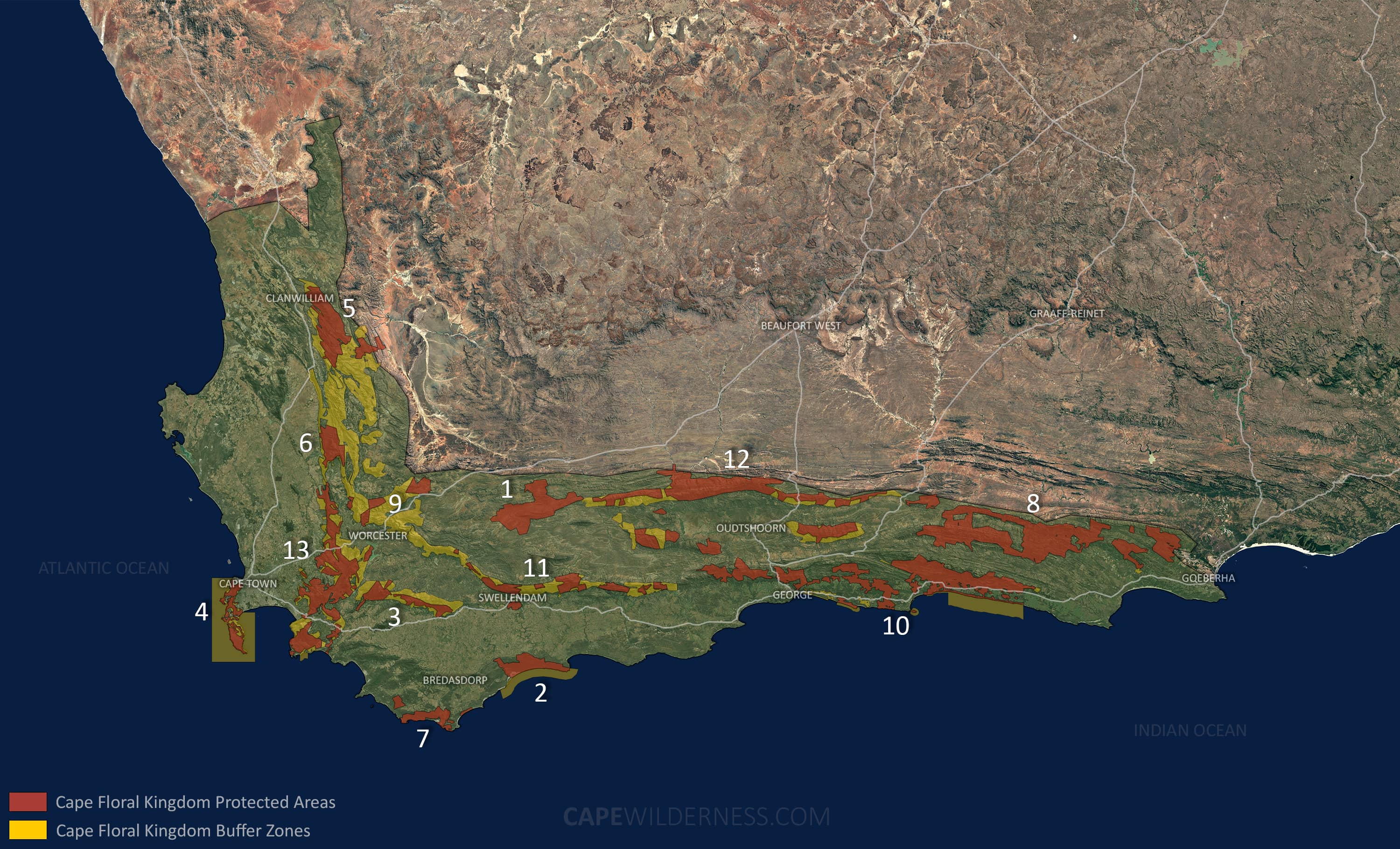
Anysberg
Nature Reserve
1
Anysberg Nature Reserve
Table Mountain
National Park
4
Table Mountain National Park
De Hoop
Nature Reserve
2
De Hoop Nature Reserve
Cederberg
Complex
5
Cederberg Wilderness Area
Matjiesrivier Nature Reserve
Riviersonderend
Nature Reserve
3
Riviersonderend Nature Reserve
Groot Winterhoek
Complex
6
Grootwinterhoek Wilderness Area
Grootwinterhoek Nature Reserve
Agulhas
Complex
7
Agulhas National Park
Quoin Point Nature Reserve
Soetendalsvlei Nature Reserve
De Mond Nature Reserve
Baviaanskloof
Complex
8
Baviaanskloof Wilderness Area
Baviaanskloof Nature Reserve
Groendal Nature Reserve
Hexrivier
Complex
9
Wittebrug Nature Reserve
Fonteintjiesberg Nature Reserve
Ben-Etive Nature Reserve
Bokkeriviere Nature Reserve
Garden Route
Complex
10
Garden Route National Park
Ruitersbos Nature Reserve
Doringsrivier Wilderness Area
Witfontein Nature Reserve
Goukamma Nature Reserve
Robberg Nature Reserve
Keurboomsrivier Nature Reserve
Formosa Nature Reserve
Formosa Provincial Nature Reserve
Langeberg
Complex
11
Boosmansbos Wilderness Area
Witbosrivier Nature Reserve
Twistniet Nature Reserve
Marloth Nature Reserve
Bontebok National Park
Zuurberg Nature Reserve
Grootvadersbosch Nature Reserve
Garcia Nature Reserve
Spioenkop Nature Reserve
Paardeberg Nature Reserve
Tygerberg Nature Reserve
Swartberg
Complex
12
Gamkapoort Nature Reserve
Groot Swartberg Nature Reserve
Gamkaskloof (Die Hel) Nature Reserve
Swartberg East Nature Reserve
Towerkop Nature Reserve
Paardenberg Nature Reserve
Rooiberg Nature Reserve
Groenfontein Nature Reserve
Gamkaberg Nature Reserve
Kammanassie Nature Reserve
13
Boland Mountain
Complex
Hawequa Nature Reserve
Theewaters Nature Reserve
Jonkershoek Nature Reserve
Hottentots-Holland Nature Reserve
Groenlandberg Nature Reserve
Houwhoek Nature Reserve
Kogelberg Nature Reserve
Mt Hebron Nature Reserve
Waterval Nature Reserve
Voëlvlei Nature Reserve
Brandvlei Nature Reserve
Simonsberg Nature Reserve
Helderberg Nature Reserve
Kogelberg Sonchem Link Nature Reserve
Brodie Link Nature Reserve
Rooisand (Botrivier) Nature Reserve
